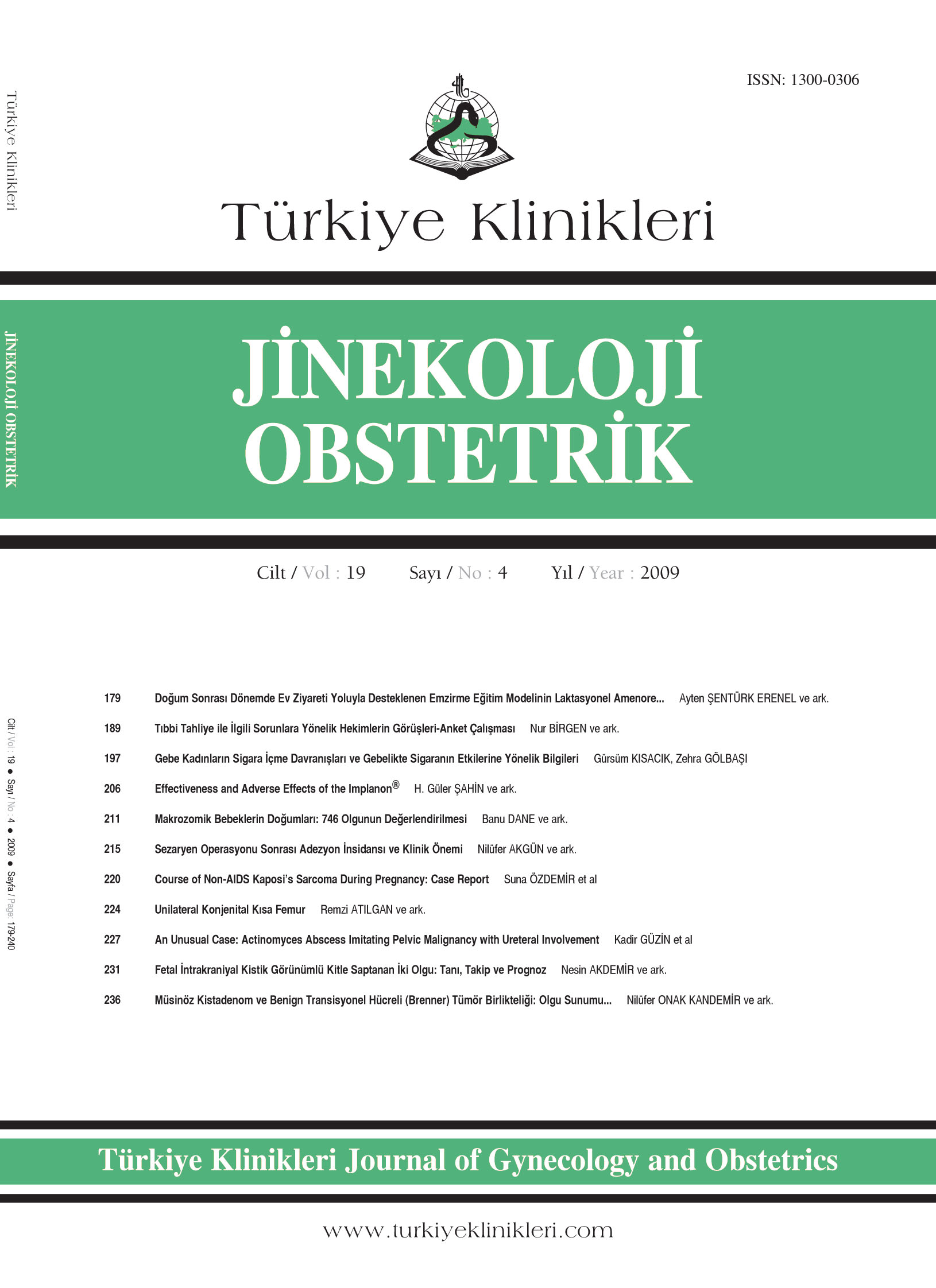Open Access
Peer Reviewed
ORIGINAL RESEARCH
1452 Viewed794 Downloaded
Randomized Comparison of Sustained-Release Dinoprostone Vaginal Insert Versus Oxytocin for Cervical Priming/Labor Induction in Post-Term Pregnants with Unfavorable Cervix
Olgunlaşmamış Serviksi Olan Miadını Geçmiş Gebelerde Kontrollü Salınımlı Dinoproston Vajinal Ovül İle Oksitosinin Doğum Eylemi Üzerine Olan Etkilerinin Randomize Olarak Karşılaştırılması
Turkiye Klinikleri J Gynecol Obst. 2008;18(4):237-42
Article Language: EN
Copyright Ⓒ 2020 by Türkiye Klinikleri. This is an open access article under the CC BY-NC-ND license (http://creativecommons.org/licenses/by-nc-nd/4.0/)
ABSTRACT
Objective: To compare the efficacy and safety of sustained-release dinoprostone vaginal insert with low-dose oxytocin infusion for cervical ripening/labor induction. Material and Methods: Patients were randomly assigned to receive either vaginally two doses of a dinoprostone vaginal insert (dinoprostone group, n=64) or two doses of intravenous low-dose oxytocin (oxytocin group, n=63) at 12 hr intervals. The main outcomes were vaginal delivery by ≤24 hrs and overall cesarean delivery rates. Secondary outcomes included changes in Bishop's score by 12 hr, the rate of uterine hyperstimulation syndrome, duration of stages of labor, immediate neonatal complications including meconium-stained amniotic fluid, 5-min Apgar score ≤ 7 and the rate of admission to neonatal intensive care unit. Results: Patients achieved vaginal delivery by ≤ 24 hours in the dinoprostone group (53.1 %) was similar to those patients in the oxytocin group (53.9 %). Overall cesarean delivery rate was 42.6 % in the oxytocin group and 32.8% in the dinoprostone group (P>0.05). There were no statistically significant differences between the groups regarding secondary outcomes. Conclusions: Both dinoprostone vaginal insert and low-dose oxytocin infusion were similar in efficacy for cervical priming/labor induction and safety for maternal and fetal outcomes. Moreover time to delivery in oxytocin group was more likely to be shorter; however, cesarean delivery rate in dinoprostone group was more likely to be lower.
Objective: To compare the efficacy and safety of sustained-release dinoprostone vaginal insert with low-dose oxytocin infusion for cervical ripening/labor induction. Material and Methods: Patients were randomly assigned to receive either vaginally two doses of a dinoprostone vaginal insert (dinoprostone group, n=64) or two doses of intravenous low-dose oxytocin (oxytocin group, n=63) at 12 hr intervals. The main outcomes were vaginal delivery by ≤24 hrs and overall cesarean delivery rates. Secondary outcomes included changes in Bishop's score by 12 hr, the rate of uterine hyperstimulation syndrome, duration of stages of labor, immediate neonatal complications including meconium-stained amniotic fluid, 5-min Apgar score ≤ 7 and the rate of admission to neonatal intensive care unit. Results: Patients achieved vaginal delivery by ≤ 24 hours in the dinoprostone group (53.1 %) was similar to those patients in the oxytocin group (53.9 %). Overall cesarean delivery rate was 42.6 % in the oxytocin group and 32.8% in the dinoprostone group (P>0.05). There were no statistically significant differences between the groups regarding secondary outcomes. Conclusions: Both dinoprostone vaginal insert and low-dose oxytocin infusion were similar in efficacy for cervical priming/labor induction and safety for maternal and fetal outcomes. Moreover time to delivery in oxytocin group was more likely to be shorter; however, cesarean delivery rate in dinoprostone group was more likely to be lower.
ÖZET
Amaç: Postterm gebeliği ve elverişsiz serviksi olan hastalarda, serviks olgunlaşması/doğum eylemi indüksiyonu için yavaş serbestleşen dinoproston vajinal ovül ile düşük doz intravenöz oksitosin infüzyonunun doğum eylemi üzerine olan etkinliği ve anne ile fetüs için güvenliğini karşılaştırmak. Gereç ve Yöntemler: Hastalar 12 saat ara ile 2 doz PGE2 vajinal ovül (n=64) veya intravenöz oksitosin (n=63) almak üzere rastgele iki gruba ayrıldı. Ana sonuç ölçütleri sezaryen doğum oranı ve ≤ 24 saatte vajinal doğumdu. Ölçülen sekonder ölçütler şunlardı: 12 saatte Bishop puanındaki değişikler; uterus hiperstimülasyon sendromu oranı; doğum eylemi evrelerinin süresi; mekonyum boyanmış amniyon sıvısını, 5. dakika Apgar puanı ≤ 7 ve neonatal yoğun bakım ünitesine yatış oranını içeren erken neonatal komplikasyonlardı. Bulgular: İlk 24 saatte, vajinal yolla doğum gerçekleştiren dinoproston grubundaki hastalar (%53,1), oksitosin grubundaki vajinal yolla doğum yapan hastalardan (%53,9) istatistiksel olarak farklı değildi (P=1,00). Genel sezaryen oranı oksitosin grubunda % 42,6 ve dinoproston grubunda % 32,8 idi (P>0.05). Sekonder ölçüm parametreleri açısından iki grup arasında istatistiksel olarak anlamlı fark yoktu. Sonuç: Olgunlaşmamış serviksi bulunan postterm gebelerde, yavaş salınımlı dinoproston vajinal ovül ve düşük doz oksitosin, doğum eylemi üzerine olan etkileri, maternal ve fetal yan etkileri açısından benzer özelliklere sahipti. Ayrıca, oksitosin grubunda doğuma kadar geçen süre daha kısa iken dinoproston grubunda sezaryen doğum oranı daha düşüktü.
Amaç: Postterm gebeliği ve elverişsiz serviksi olan hastalarda, serviks olgunlaşması/doğum eylemi indüksiyonu için yavaş serbestleşen dinoproston vajinal ovül ile düşük doz intravenöz oksitosin infüzyonunun doğum eylemi üzerine olan etkinliği ve anne ile fetüs için güvenliğini karşılaştırmak. Gereç ve Yöntemler: Hastalar 12 saat ara ile 2 doz PGE2 vajinal ovül (n=64) veya intravenöz oksitosin (n=63) almak üzere rastgele iki gruba ayrıldı. Ana sonuç ölçütleri sezaryen doğum oranı ve ≤ 24 saatte vajinal doğumdu. Ölçülen sekonder ölçütler şunlardı: 12 saatte Bishop puanındaki değişikler; uterus hiperstimülasyon sendromu oranı; doğum eylemi evrelerinin süresi; mekonyum boyanmış amniyon sıvısını, 5. dakika Apgar puanı ≤ 7 ve neonatal yoğun bakım ünitesine yatış oranını içeren erken neonatal komplikasyonlardı. Bulgular: İlk 24 saatte, vajinal yolla doğum gerçekleştiren dinoproston grubundaki hastalar (%53,1), oksitosin grubundaki vajinal yolla doğum yapan hastalardan (%53,9) istatistiksel olarak farklı değildi (P=1,00). Genel sezaryen oranı oksitosin grubunda % 42,6 ve dinoproston grubunda % 32,8 idi (P>0.05). Sekonder ölçüm parametreleri açısından iki grup arasında istatistiksel olarak anlamlı fark yoktu. Sonuç: Olgunlaşmamış serviksi bulunan postterm gebelerde, yavaş salınımlı dinoproston vajinal ovül ve düşük doz oksitosin, doğum eylemi üzerine olan etkileri, maternal ve fetal yan etkileri açısından benzer özelliklere sahipti. Ayrıca, oksitosin grubunda doğuma kadar geçen süre daha kısa iken dinoproston grubunda sezaryen doğum oranı daha düşüktü.
MENU
POPULAR ARTICLES
MOST DOWNLOADED ARTICLES





This journal is licensed under a Creative Commons Attribution-NonCommercial-NoDerivatives 4.0 International License.











